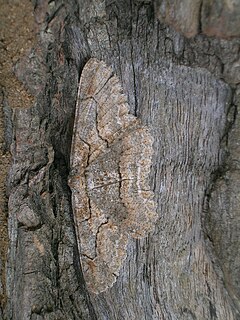
Hypomecis is a genus of moths in the family Geometridae first described by Jacob Hübner in 1821.
Brana is a monotypic moth genus of the family Noctuidae. Its only species, Brana calopasa, is found in Sri Lanka and Australia. Both the genus and species were described by Francis Walker, the genus in 1858 and the species in 1859. It It is a serious pest on Berrya cordifolia.
Radara subcupralis is a moth of the family Noctuidae first described by Francis Walker in 1866.

Anomis mesogona is a moth of the family Erebidae first described by Francis Walker in 1857. It is found in India, Sri Lanka, Somalia and Japan.

Cleora alienaria is a moth of the family Geometridae first described by Francis Walker in 1860. It is found in Sri Lanka, the Indian subregion to the Andaman Islands, Thailand, Sundaland, Taiwan, and Lesser Sundas as far east as Timor and Christmas Island.
Cusiala raptaria is a moth of the family Geometridae first described by Francis Walker in 1860. It is found in the Indian subregion and Sri Lanka.
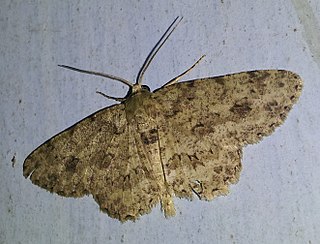
Ectropis bhurmitra, the tea twig caterpillar, is a moth of the family Geometridae. The species was first described by Francis Walker in 1860. A widespread Asian species, it is found around Indo-Australian tropics from India, Sri Lanka and Hong Kong, Taiwan, Thailand, New Guinea to Australian Queensland and the Solomon Islands.
Hypochrosis chlorozonaria is a moth of the family Geometridae first described by Francis Walker in 1860. It is found in Sri Lanka.
Hypomecis adamata is a moth of the family Geometridae first described by Felder in 1874. It is found in Sri Lanka.
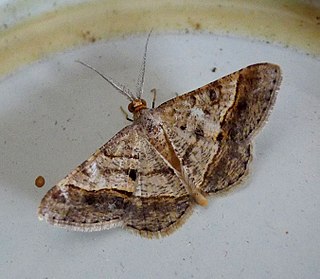
Isturgia pulinda is a moth of the family Geometridae first described by Francis Walker in 1860. The species has a widespread distribution from the African countries of Botswana, Ethiopia, the Gambia, Kenya, Malawi, Mozambique, South Africa, Tanzania, Zambia and Zimbabwe to Saudi Arabia and Yemen towards the Indian subregion and Sri Lanka. In Europe, it is found in the Canary Islands, Spain, Portugal and the Cape Verde Islands.
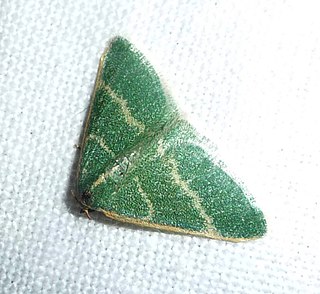
Microloxia herbaria, the herb emerald, is a moth of the family Geometridae. The species was first described by Jacob Hübner in 1808. It is a widespread species that can be found along the Mediterranean region, southern Europe, central Asia towards southern Asia including India, Pakistan and Sri Lanka and to the Russian Far East.
Luxiaria phyllosaria is a moth of the family Geometridae first described by Francis Walker in 1860. It is found in Sri Lanka, the north-eastern Himalayas of India, Sumatra, Borneo, the Philippines and Sulawesi.
Noreia ajaia is a moth of the family Geometridae first described by Francis Walker in 1859. Its geographical range includes areas from the Oriental regions of India and Sri Lanka to Singapore and Sundaland.
Ophthalmitis caritaria is a moth of the family Geometridae first described by Francis Walker in 1860. It is found in Sri Lanka.
Ozola microniaria is a moth of the family Geometridae first described by Francis Walker in 1862. It is found in Sri Lanka.
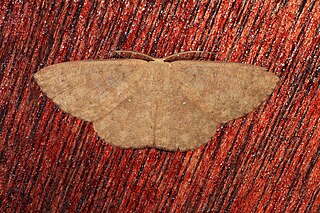
Perixera absconditaria is a moth of the family Geometridae first described by Francis Walker in 1862. It is found in the Indian subregion, Sri Lanka, to Taiwan, Sundaland and the Philippines.
Ruttelerona cessaria is a moth of the family Geometridae first described by Francis Walker in 1860. It is found in Sri Lanka and South India.
Scardamia bractearia is a moth of the family Geometridae first described by Francis Walker in 1860. It is found in Sri Lanka.
Semiothisa ozararia, is a moth of the family Geometridae first described by Francis Walker in 1860. It is found in the Indian subregion, Sri Lanka, Taiwan, Borneo, Sumatra and Java.
Dysaethria conflictaria, or Epiplema conflictaria, is a moth of the family Uraniidae first described by Francis Walker in 1861. It is found in Indo-Australian tropics of India, Sri Lanka, Thailand, Papua New Guinea, the Solomon Islands and Australia.







